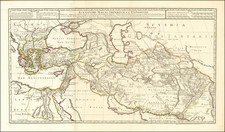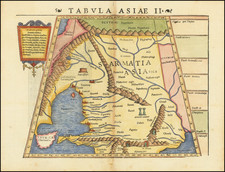Detailed map following the course of the Volga River from north of Moscow and Novogardia to the Caspian Sea, extending west to the Black Sea and south to Armenia.
The map appeared in Munster's Cosmographia, first published in 1545, one of the most influential works of the 16th Century, which was published in an number of editions and languages on a continuous basis from 1545 to 1624, by which time it had grown to more than 1000 maps, views and illustrations.
Sebastian Münster (1488-1552) was a cosmographer and professor of Hebrew who taught at Tübingen, Heidelberg, and Basel. He settled in the latter in 1529 and died there, of plague, in 1552. Münster made himself the center of a large network of scholars from whom he obtained geographic descriptions, maps, and directions.
As a young man, Münster joined the Franciscan order, in which he became a priest. He then studied geography at Tübingen, graduating in 1518. He moved to Basel, where he published a Hebrew grammar, one of the first books in Hebrew published in Germany. In 1521 Münster moved again, to Heidelberg, where he continued to publish Hebrew texts and the first German-produced books in Aramaic. After converting to Protestantism in 1529, he took over the chair of Hebrew at Basel, where he published his main Hebrew work, a two-volume Old Testament with a Latin translation.
Münster published his first known map, a map of Germany, in 1525. Three years later, he released a treatise on sundials. In 1540, he published Geographia universalis vetus et nova, an updated edition of Ptolemy’s Geographia. In addition to the Ptolemaic maps, Münster added 21 modern maps. One of Münster’s innovations was to include one map for each continent, a concept that would influence Ortelius and other early atlas makers. The Geographia was reprinted in 1542, 1545, and 1552.
He is best known for his Cosmographia universalis, first published in 1544 and released in at least 35 editions by 1628. It was the first German-language description of the world and contained 471 woodcuts and 26 maps over six volumes. Many of the maps were taken from the Geographia and modified over time. The Cosmographia was widely used in the sixteenth and seventeenth centuries. The text, woodcuts, and maps all influenced geographical thought for generations.










![[Armenia] Pianta dell'Armenia Secondo il Tratto di Berlino](https://storage.googleapis.com/raremaps/img/small/90949.jpg)
![[Hydrographic Map of European Russia] ГИДРОГРАФИЧЕСКАЯ КАРТА ЕВРОПЕЙСКОЙ РОССИИ](https://storage.googleapis.com/raremaps/img/small/54482.jpg)
![[Fascist Organizations of Germany] Фашистские Организации Германии](https://storage.googleapis.com/raremaps/img/small/67801.jpg)

![Persia [shows Armenia]](https://storage.googleapis.com/raremaps/img/small/72526.jpg)